The Cambridge History of Japan, Vol. 1: Ancient Japan
Подождите немного. Документ загружается.

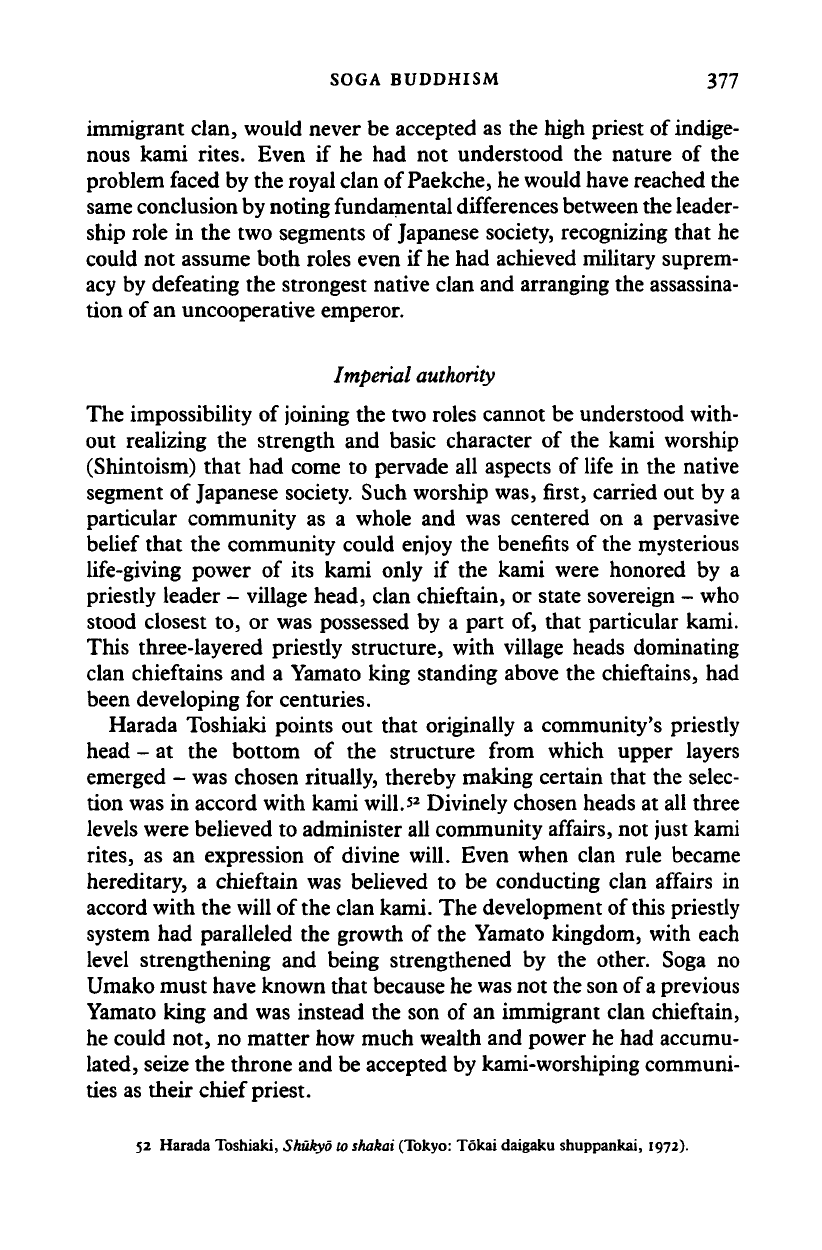
SOGA BUDDHISM 377
immigrant clan, would never be accepted as the high priest of indige-
nous kami rites. Even if he had not understood the nature of the
problem faced by the royal clan of Paekche, he would have reached the
same conclusion by noting fundamental differences between the leader-
ship role in the two segments of Japanese society, recognizing that he
could not assume both roles even if he had achieved military suprem-
acy by defeating the strongest native clan and arranging the assassina-
tion of an uncooperative emperor.
Imperial authority
The impossibility of joining the two roles cannot be understood with-
out realizing the strength and basic character of the kami worship
(Shintoism) that had come to pervade all aspects of life in the native
segment of Japanese society. Such worship was, first, carried out by a
particular community as a whole and was centered on a pervasive
belief that the community could enjoy the benefits of the mysterious
life-giving power of its kami only if the kami were honored by a
priestly leader - village head, clan chieftain, or state sovereign - who
stood closest to, or was possessed by a part of, that particular kami.
This three-layered priestly structure, with village heads dominating
clan chieftains and a Yamato king standing above the chieftains, had
been developing for centuries.
Harada Toshiaki points out that originally a community's priestly
head - at the bottom of the structure from which upper layers
emerged - was chosen ritually, thereby making certain that the selec-
tion was in accord with kami will.'
2
Divinely chosen heads at all three
levels were believed to administer all community affairs, not just kami
rites,
as an expression of divine will. Even when clan rule became
hereditary, a chieftain was believed to be conducting clan affairs in
accord with the will of
the
clan kami. The development of this priestly
system had paralleled the growth of the Yamato kingdom, with each
level strengthening and being strengthened by the other. Soga no
Umako must have known that because he was not the son of
a
previous
Yamato king and was instead the son of an immigrant clan chieftain,
he could not, no matter how much wealth and power he had accumu-
lated, seize the throne and be accepted by kami-worshiping communi-
ties as their chief priest.
52 Harada Toshiaki, Shukyo to shakai (Tokyo: Tokai daigaku shuppankai, 1972).
Cambridge Histories Online © Cambridge University Press, 2008
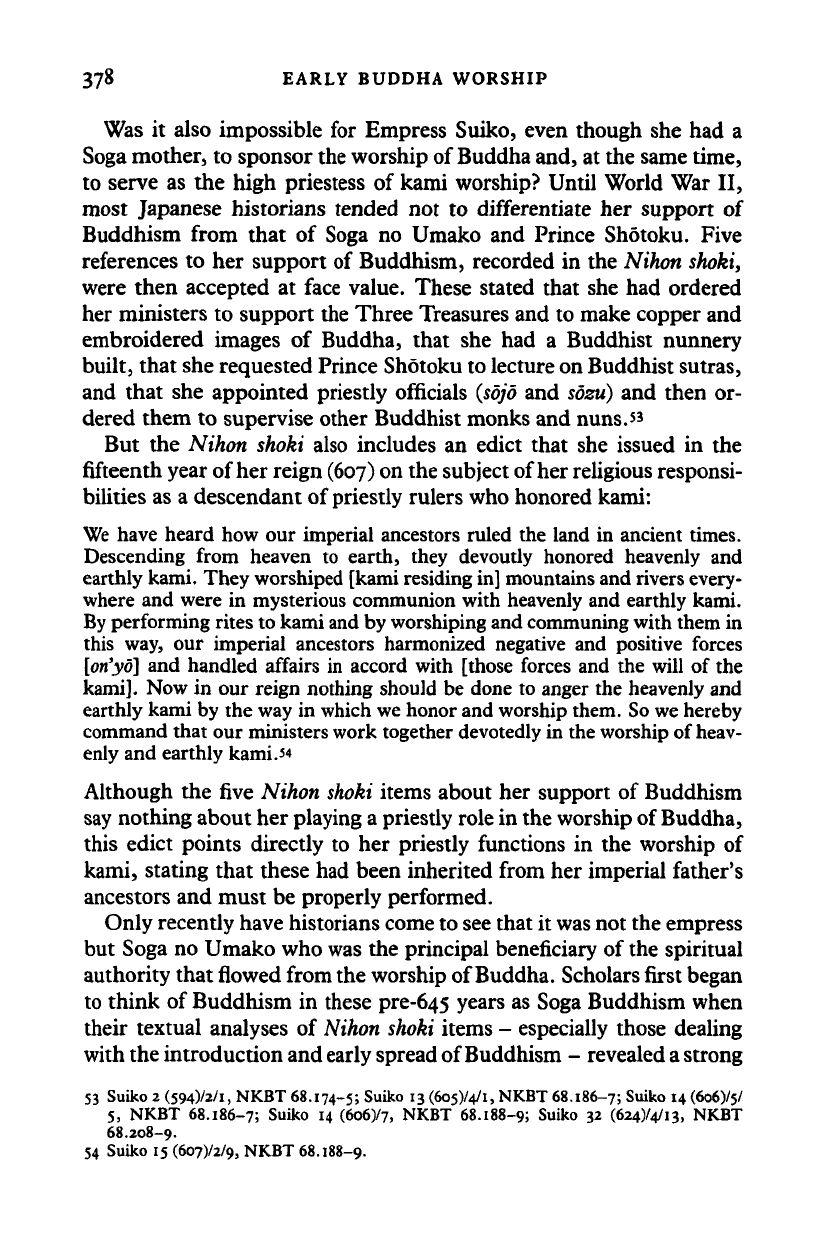
378 EARLY BUDDHA WORSHIP
Was it also impossible for Empress Suiko, even though she had a
Soga mother, to sponsor the worship of Buddha and, at the same time,
to serve as the high priestess of kami worship? Until World War II,
most Japanese historians tended not to differentiate her support of
Buddhism from that of Soga no Umako and Prince Shotoku. Five
references to her support of Buddhism, recorded in the Nihon shoki,
were then accepted at face value. These stated that she had ordered
her ministers to support the Three Treasures and to make copper and
embroidered images of Buddha, that she had a Buddhist nunnery
built, that she requested Prince Shotoku to lecture on Buddhist sutras,
and that she appointed priestly officials
(sojo
and
sozu)
and then or-
dered them to supervise other Buddhist monks and nuns.53
But the Nihon shoki also includes an edict that she issued in the
fifteenth year of her reign (607) on the subject of her religious responsi-
bilities as a descendant of priestly rulers who honored kami:
We have heard how our imperial ancestors ruled the land in ancient times.
Descending from heaven to earth, they devoutly honored heavenly and
earthly kami. They worshiped [kami residing in] mountains and rivers every-
where and were in mysterious communion with heavenly and earthly kami.
By performing rites to kami and by worshiping and communing with them in
this way, our imperial ancestors harmonized negative and positive forces
[on'yd]
and handled affairs in accord with [those forces and the will of the
kami].
Now in our reign nothing should be done to anger the heavenly and
earthly kami by the way in which we honor and worship them. So we hereby
command that our ministers work together devotedly in the worship of heav-
enly and earthly kami.*»
Although the five Nihon
shoki
items about her support of Buddhism
say nothing about her playing a priestly role in the worship of Buddha,
this edict points directly to her priestly functions in the worship of
kami, stating that these had been inherited from her imperial father's
ancestors and must be properly performed.
Only recently have historians come to see that it
was
not the empress
but Soga no Umako who was the principal beneficiary of the spiritual
authority that
flowed
from the worship of Buddha. Scholars first began
to think of Buddhism in these pre-645 years as Soga Buddhism when
their textual analyses of Nihon
shoki
items - especially those dealing
with the introduction and early spread of Buddhism - revealed
a
strong
53 Suiko 2 (594)/2/i, NKBT 68.174-5; Suiko 13 (6o5)/4/l, NKBT 68.186-7; Suiko 14 (6o6)/5/
5, NKBT 68.186-7; Suiko 14 (6o6)/7, NKBT 68.188-9; Suiko 32 (624)/4/i3, NKBT
68.208-9.
54 Suiko 15 (607X2/9, NKBT 68.188-9.
Cambridge Histories Online © Cambridge University Press, 2008
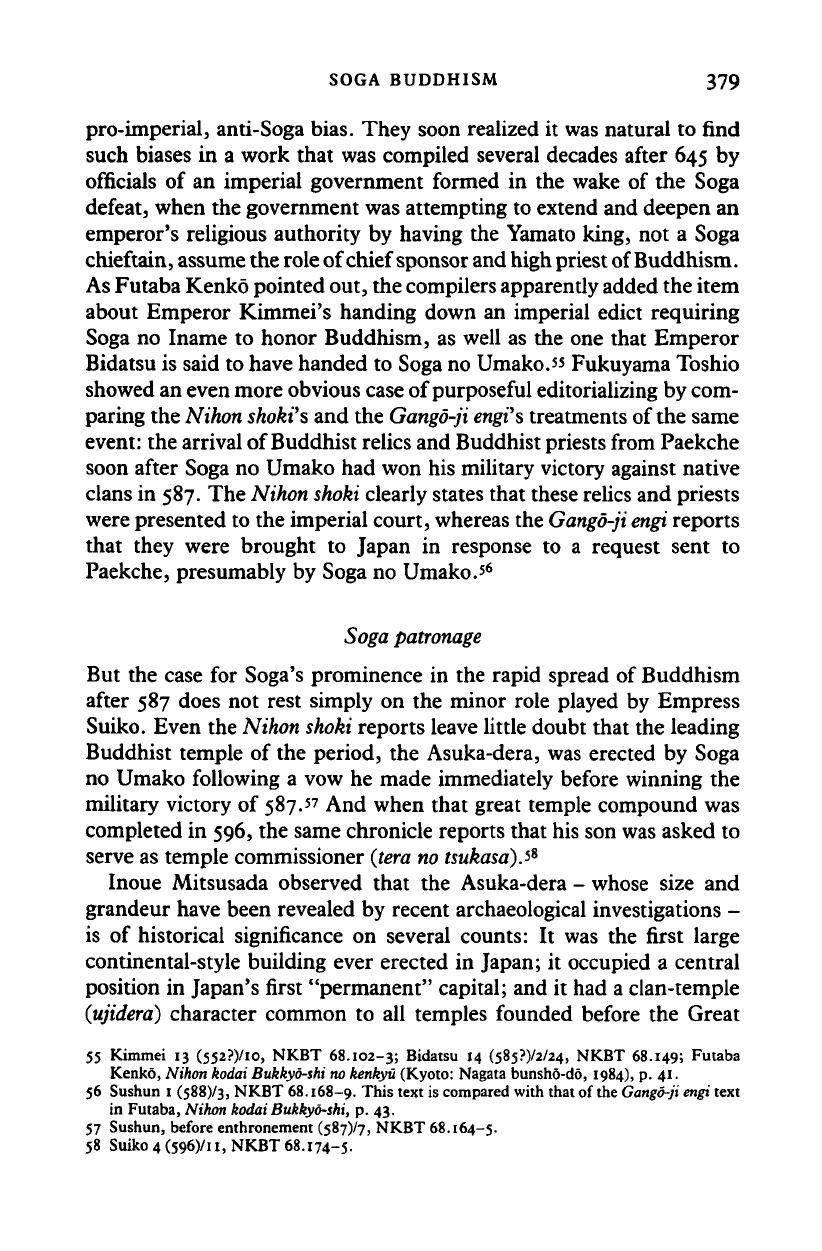
SOGA BUDDHISM 379
pro-imperial, anti-Soga bias. They soon realized it was natural to find
such biases in a work that was compiled several decades after 645 by
officials of an imperial government formed in the wake of the Soga
defeat, when the government was attempting to extend and deepen an
emperor's religious authority by having the Yamato king, not a Soga
chieftain, assume the
role
of chief sponsor and high priest of Buddhism.
As
Futaba Kenko pointed out, the compilers apparently added the item
about Emperor Kimmei's handing down an imperial edict requiring
Soga no Iname to honor Buddhism, as well as the one that Emperor
Bidatsu is said to have handed to Soga no Umako.55 Fukuyama Toshio
showed an even more obvious case of purposeful editorializing by com-
paring the Nihon
shoki's
and the
Gango-ji engi's
treatments of the same
event: the arrival of Buddhist relics and Buddhist priests from Paekche
soon after Soga no Umako had won his military victory against native
clans in 587. The Nihon
shoki
clearly states that these relics and priests
were presented to the imperial court, whereas the
Gango-ji engi
reports
that they were brought to Japan in response to a request sent to
Paekche, presumably by Soga no Umako.
56
Soga patronage
But the case for Soga's prominence in the rapid spread of Buddhism
after 587 does not rest simply on the minor role played by Empress
Suiko. Even the Nihon
shoki
reports leave little doubt that the leading
Buddhist temple of the period, the Asuka-dera, was erected by Soga
no Umako following a vow he made immediately before winning the
military victory of 587.57 And when that great temple compound was
completed in 596, the same chronicle reports that his son was asked to
serve as temple commissioner
(tera no
tsukasa)J*
Inoue Mitsusada observed that the Asuka-dera - whose size and
grandeur have been revealed by recent archaeological investigations -
is of historical significance on several counts: It was the first large
continental-style building ever erected in Japan; it occupied a central
position in Japan's first "permanent" capital; and it had a clan-temple
(ujidera)
character common to all temples founded before the Great
55 Kimmei 13 (552?)/io, NKBT 68.102-3; Bidatsu 14 (585?)/2/24, NKBT 68.149; Futaba
Kenko, Nihon kodai Bukkyo-shi no
kenkyu
(Kyoto: Nagata bunsho-do, 1984), p. 41.
56 Sushun 1 (588)/3, NKBT 68.168-9. This text is compared with that of the Gango-ji engi text
in Futaba, Nihon kodai Bukkyo-shi, p. 43.
57 Sushun, before enthronement (587X7, NKBT 68.164-5.
58 Suiko 4 (596)/!!, NKBT 68.174-5.
Cambridge Histories Online © Cambridge University Press, 2008
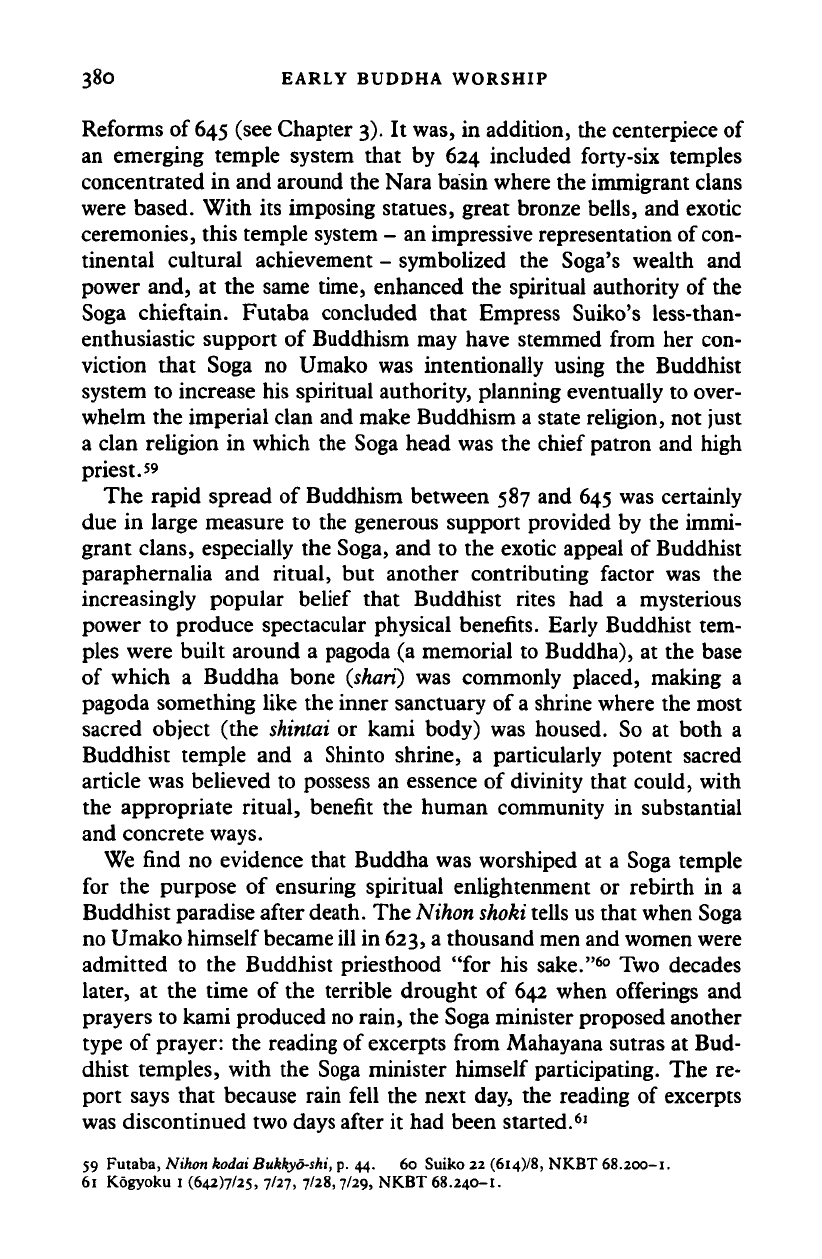
380 EARLY BUDDHA WORSHIP
Reforms of
645
(see Chapter 3). It was, in addition, the centerpiece of
an emerging temple system that by 624 included forty-six temples
concentrated in and around the Nara basin where the immigrant clans
were based. With its imposing statues, great bronze bells, and exotic
ceremonies, this temple system - an impressive representation of con-
tinental cultural achievement - symbolized the Soga's wealth and
power and, at the same time, enhanced the spiritual authority of the
Soga chieftain. Futaba concluded that Empress Suiko's less-than-
enthusiastic support of Buddhism may have stemmed from her con-
viction that Soga no Umako was intentionally using the Buddhist
system to increase his spiritual authority, planning eventually to over-
whelm the imperial clan and make Buddhism a state religion, not just
a clan religion in which the Soga head was the chief patron and high
priest. 59
The rapid spread of Buddhism between 587 and 645 was certainly
due in large measure to the generous support provided by the immi-
grant clans, especially the Soga, and to the exotic appeal of Buddhist
paraphernalia and ritual, but another contributing factor was the
increasingly popular belief that Buddhist rites had a mysterious
power to produce spectacular physical benefits. Early Buddhist tem-
ples were built around a pagoda (a memorial to Buddha), at the base
of which a Buddha bone (shari) was commonly placed, making a
pagoda something like the inner sanctuary of
a
shrine where the most
sacred object (the
shintai
or kami body) was housed. So at both a
Buddhist temple and a Shinto shrine, a particularly potent sacred
article was believed to possess an essence of divinity that could, with
the appropriate ritual, benefit the human community in substantial
and concrete ways.
We find no evidence that Buddha was worshiped at a Soga temple
for the purpose of ensuring spiritual enlightenment or rebirth in a
Buddhist paradise after death. The Nihon
shoki
tells us that when Soga
no Umako himself became ill in
623,
a thousand men and women were
admitted to the Buddhist priesthood "for his sake."
60
Two decades
later, at the time of the terrible drought of 642 when offerings and
prayers to kami produced no rain, the Soga minister proposed another
type of prayer: the reading of excerpts from Mahayana sutras at Bud-
dhist temples, with the Soga minister himself participating. The re-
port says that because rain fell the next day, the reading of excerpts
was discontinued two days after it had been started.
61
59 Futaba, Nihon kodai Bukkyo-shi, p. 44. 60 Suiko 22 (6i4)/8, NKBT 68.200-1.
61 Kogyoku 1 (642)7/25, 7/27, 7/28,7/29, NKBT 68.240-1.
Cambridge Histories Online © Cambridge University Press, 2008
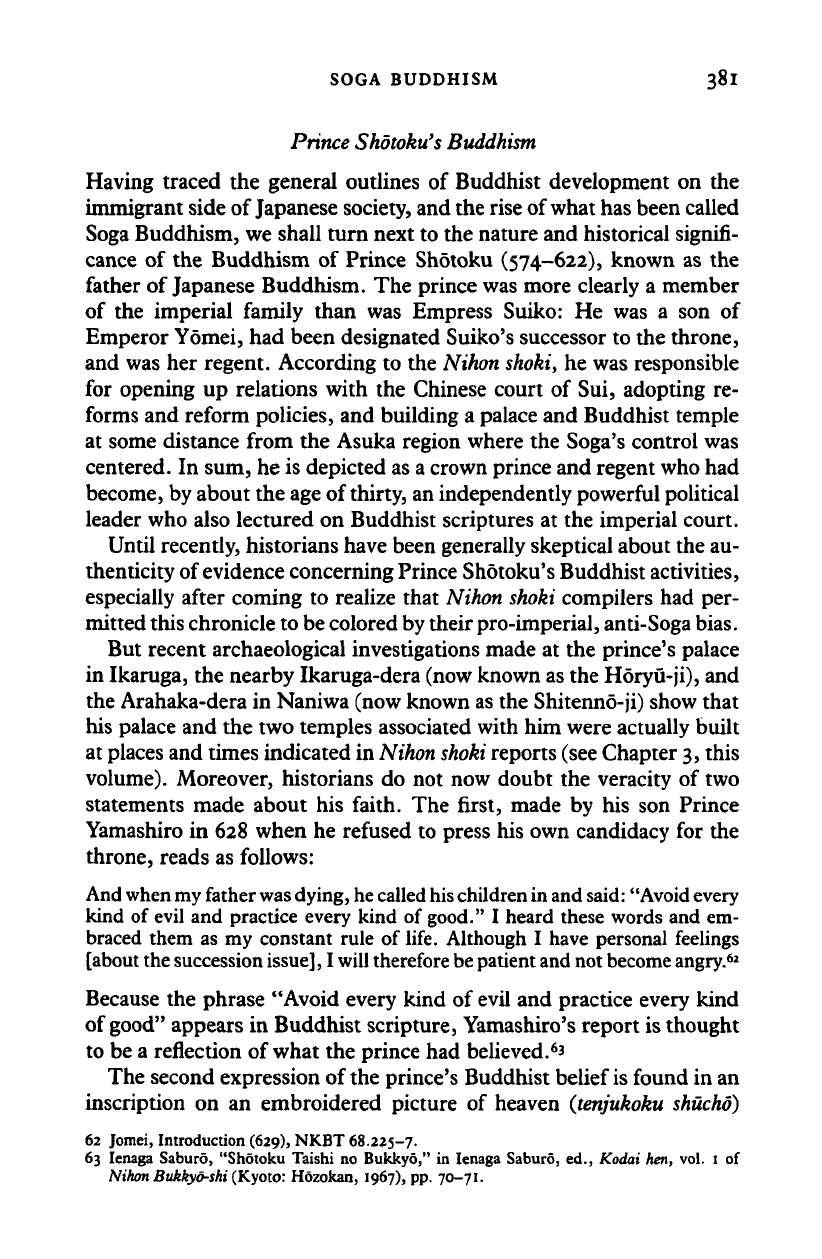
SOGA BUDDHISM 381
Prince Shotoku's Buddhism
Having traced the general outlines of Buddhist development on the
immigrant side of Japanese society, and the rise of what has been called
Soga Buddhism, we shall turn next to the nature and historical signifi-
cance of the Buddhism of Prince Shotoku (574-622), known as the
father of Japanese Buddhism. The prince was more clearly a member
of the imperial family than was Empress Suiko: He was a son of
Emperor Yomei, had been designated Suiko's successor to the throne,
and was her regent. According to the Nihon shoki, he was responsible
for opening up relations with the Chinese court of Sui, adopting re-
forms and reform policies, and building a palace and Buddhist temple
at some distance from the Asuka region where the Soga's control was
centered. In sum, he is depicted as a crown prince and regent who had
become, by about the age of thirty, an independently powerful political
leader who also lectured on Buddhist scriptures at the imperial court.
Until recently, historians have been generally skeptical about the au-
thenticity of evidence concerning Prince Shotoku's Buddhist activities,
especially after coming to realize that Nihon shoki compilers had per-
mitted this chronicle to be colored by their pro-imperial, anti-Soga bias.
But recent archaeological investigations made at the prince's palace
in Ikaruga, the nearby Ikaruga-dera (now known as the Horyu-ji), and
the Arahaka-dera in Naniwa (now known as the Shitenno-ji) show that
his palace and the two temples associated with him were actually built
at places and times indicated in Nihon shoki reports (see Chapter 3, this
volume). Moreover, historians do not now doubt the veracity of two
statements made about his faith. The first, made by his son Prince
Yamashiro in 628 when he refused to press his own candidacy for the
throne, reads as follows:
And when
my
father
was
dying,
he
called
his
children
in
and
said:
"Avoid every
kind of evil and practice every kind of good." I heard these words and em-
braced them as my constant rule of life. Although I have personal feelings
[about the succession
issue],
I
will
therefore
be
patient and not become angry.
62
Because the phrase "Avoid every kind of evil and practice every kind
of good" appears in Buddhist scripture, Yamashiro's report is thought
to be a reflection of what the prince had believed.
6
3
The second expression of the prince's Buddhist belief is found in an
inscription on an embroidered picture of heaven (tenjukoku shucho)
62
Jomei,
Introduction
(629),
NKBT
68.225-7.
63 Ienaga
Saburo,
"Shotoku Taishi
no
Bukkyo,"
in
Ienaga
Saburo,
ed.,
Kodai
hen,
vol. 1 of
Nihon Bukkyo-shi
(Kyoto:
Hozokan,
1967),
pp.
70-71.
Cambridge Histories Online © Cambridge University Press, 2008
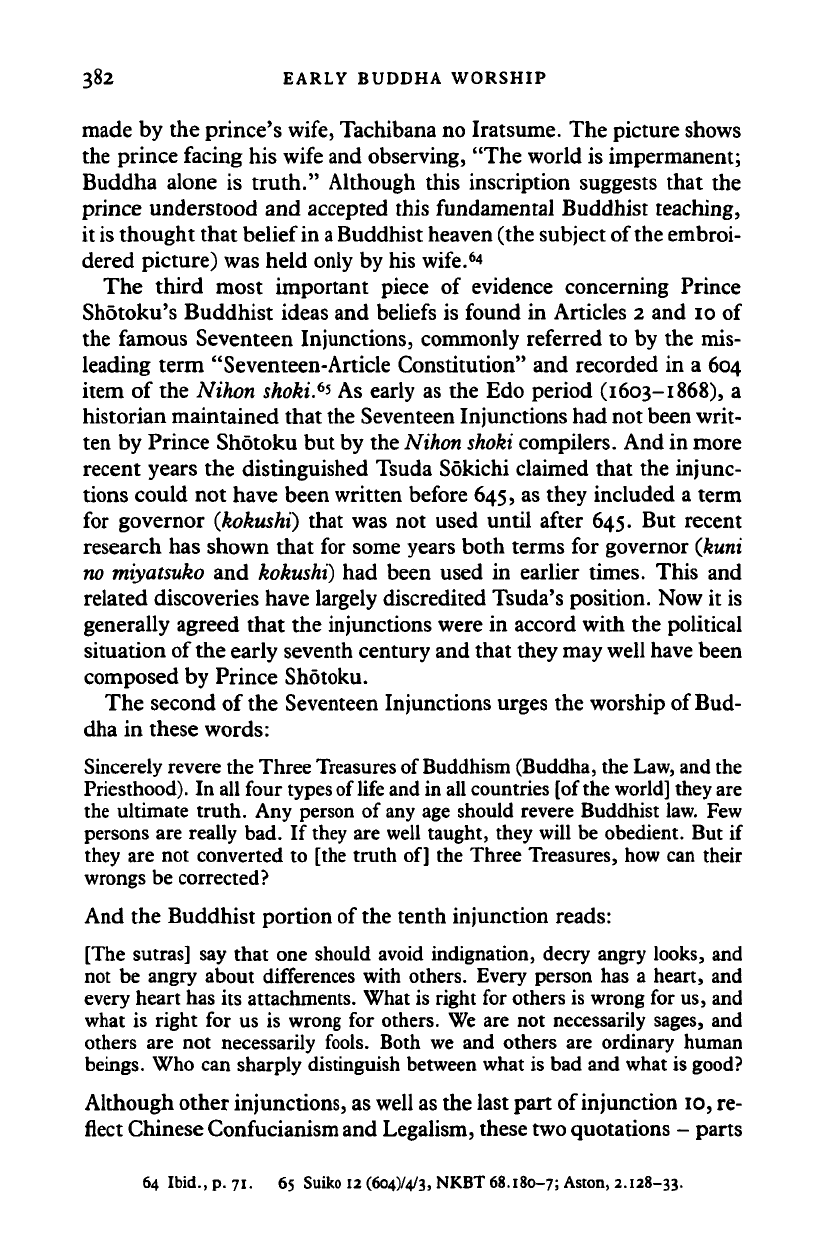
382 EARLY BUDDHA WORSHIP
made by the prince's wife, Tachibana no Iratsume. The picture shows
the prince facing his wife and observing, "The world is impermanent;
Buddha alone is truth." Although this inscription suggests that the
prince understood and accepted this fundamental Buddhist teaching,
it is thought that belief in
a
Buddhist heaven (the subject of the embroi-
dered picture) was held only by his wife.
64
The third most important piece of evidence concerning Prince
Shotoku's Buddhist ideas and beliefs is found in Articles 2 and 10 of
the famous Seventeen Injunctions, commonly referred to by the mis-
leading term "Seventeen-Article Constitution" and recorded in a 604
item of the Nihon shoki.
65
As early as the Edo period (1603-1868), a
historian maintained that the Seventeen Injunctions had not been writ-
ten by Prince Shotoku but by the Nihon shoki compilers. And in more
recent years the distinguished Tsuda Sokichi claimed that the injunc-
tions could not have been written before 645, as they included a term
for governor (kokushi) that was not used until after 645. But recent
research has shown that for some years both terms for governor
(Jkuni
no miyatsuko and kokushi) had been used in earlier times. This and
related discoveries have largely discredited Tsuda's position. Now it is
generally agreed that the injunctions were in accord with the political
situation of the early seventh century and that they may well have been
composed by Prince Shotoku.
The second of the Seventeen Injunctions urges the worship of Bud-
dha in these words:
Sincerely revere the Three Treasures of Buddhism (Buddha, the Law, and the
Priesthood). In all four types of life and in all countries [of
the
world] they are
the ultimate truth. Any person of any age should revere Buddhist law. Few
persons are really bad. If they are well taught, they will be obedient. But if
they are not converted to [the truth of] the Three Treasures, how can their
wrongs be corrected?
And the Buddhist portion of the tenth injunction reads:
[The sutras] say that one should avoid indignation, decry angry looks, and
not be angry about differences with others. Every person has a heart, and
every heart has its attachments. What is right for others is wrong for us, and
what is right for us is wrong for others. We are not necessarily sages, and
others are not necessarily fools. Both we and others are ordinary human
beings. Who can sharply distinguish between what is bad and what is good?
Although other injunctions, as well as the last part of injunction 10, re-
flect Chinese Confucianism and Legalism, these two quotations - parts
64 Ibid., p. 71. 65 Suiko 12 (604)/4/3, NKBT 68.180-7; Aston, 2.128-33.
Cambridge Histories Online © Cambridge University Press, 2008
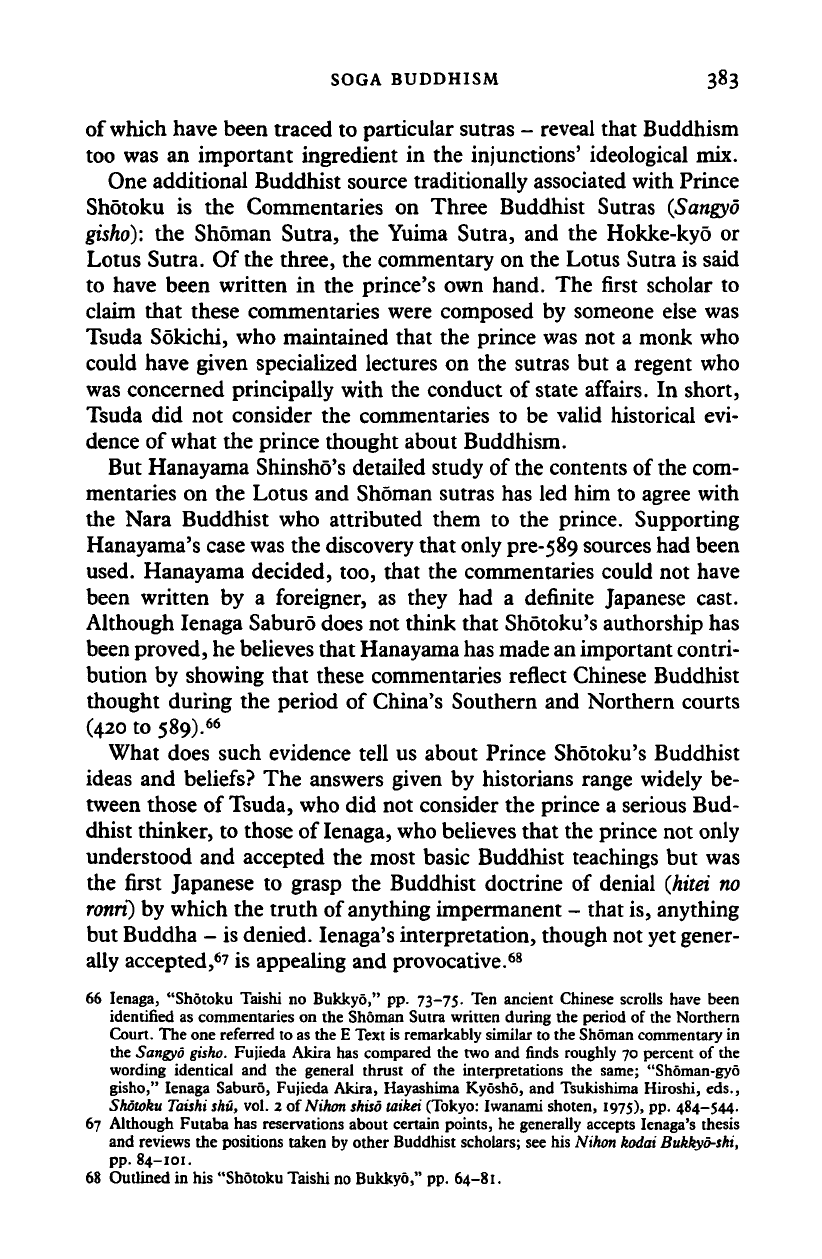
SOGA BUDDHISM 383
of which have been traced to particular sutras - reveal that Buddhism
too was an important ingredient in the injunctions' ideological mix.
One additional Buddhist source traditionally associated with Prince
Shotoku is the Commentaries on Three Buddhist Sutras (Sangyo
gisho):
the Shoman Sutra, the Yuima Sutra, and the Hokke-kyo or
Lotus Sutra. Of the three, the commentary on the Lotus Sutra is said
to have been written in the prince's own hand. The first scholar to
claim that these commentaries were composed by someone else was
Tsuda Sokichi, who maintained that the prince was not a monk who
could have given specialized lectures on the sutras but a regent who
was concerned principally with the conduct of state affairs. In short,
Tsuda did not consider the commentaries to be valid historical evi-
dence of what the prince thought about Buddhism.
But Hanayama Shinsho's detailed study of the contents of the com-
mentaries on the Lotus and Shoman sutras has led him to agree with
the Nara Buddhist who attributed them to the prince. Supporting
Hanayama's case was the discovery that only pre-589 sources had been
used. Hanayama decided, too, that the commentaries could not have
been written by a foreigner, as they had a definite Japanese cast.
Although Ienaga Saburo does not think that Shotoku's authorship has
been proved, he believes that Hanayama
has
made an important contri-
bution by showing that these commentaries reflect Chinese Buddhist
thought during the period of China's Southern and Northern courts
(420 to 589).
66
What does such evidence tell us about Prince Shotoku's Buddhist
ideas and beliefs? The answers given by historians range widely be-
tween those of Tsuda, who did not consider the prince a serious Bud-
dhist thinker, to those of Ienaga, who believes that the prince not only
understood and accepted the most basic Buddhist teachings but was
the first Japanese to grasp the Buddhist doctrine of denial (hitei no
ronri)
by which the truth of anything impermanent - that is, anything
but Buddha - is denied. Ienaga's interpretation, though not yet gener-
ally accepted,
6
? is appealing and provocative.
68
66 Ienaga, "Shotoku Taishi no Bukkyo," pp. 73-75. Ten ancient Chinese scrolls have been
identified as commentaries on the Shoman Sutra written during the period of the Northern
Court. The one referred to as the E Text is remarkably similar to the Shoman commentary in
the Sangyo gisho. Fujieda Akira has compared the two and finds roughly 70 percent of the
wording identical and the general thrust of the interpretations the same; "Shoman-gyo
gisho,"
Ienaga Saburo, Fujieda Akira, Hayashima Kyosho, and Tsukishima Hiroshi, eds.,
Shotoku
Taishi
shu, vol. 2 oiNihon
shiso
laikei (Tokyo: Iwanami shoten, 1975), pp. 484-544.
67 Although Futaba has reservations about certain points, he generally accepts Ienaga's thesis
and reviews the positions taken by other Buddhist scholars; see his Nihon kodai Bukkyo-shi,
pp.
84-101.
68 Outlined in his "Shotoku Taishi no Bukkyo," pp.
64-81.
Cambridge Histories Online © Cambridge University Press, 2008
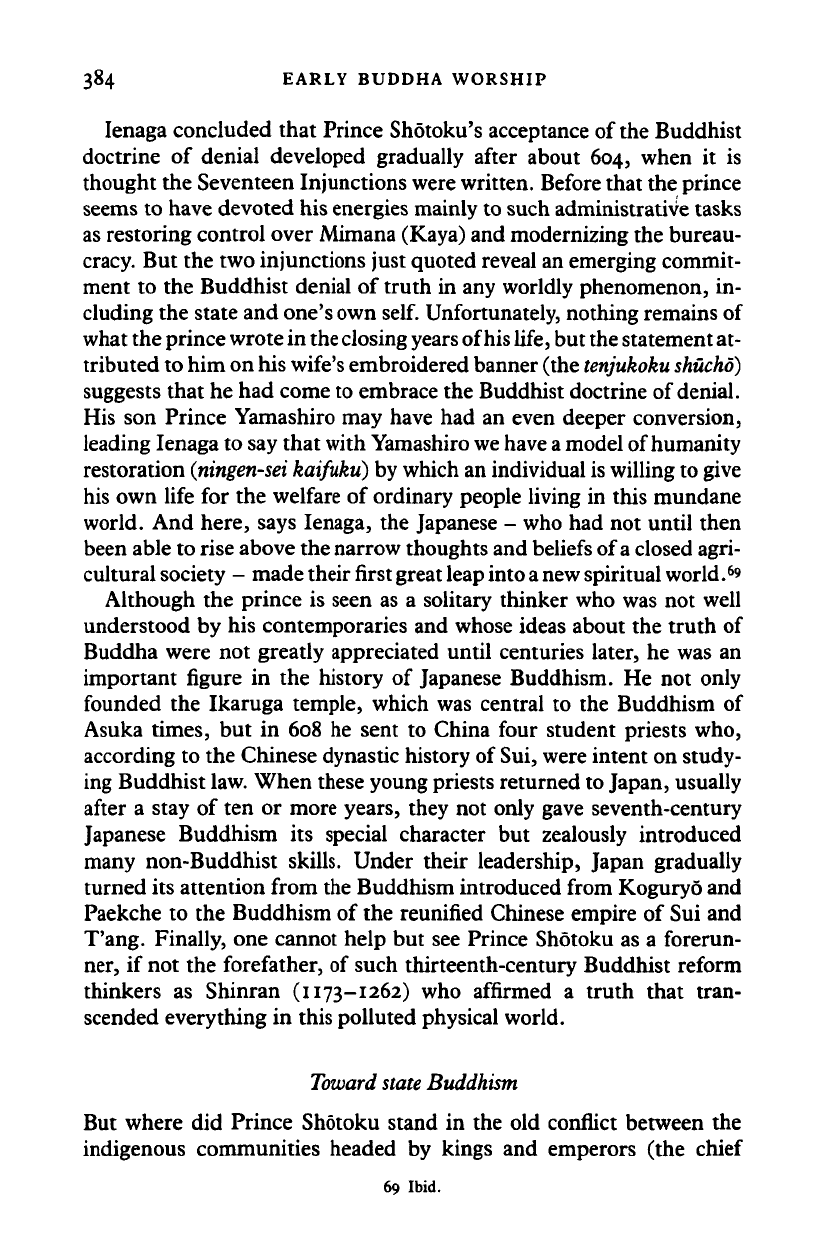
384 EARLY BUDDHA WORSHIP
Ienaga concluded that Prince Shotoku's acceptance of the Buddhist
doctrine of denial developed gradually after about 604, when it is
thought the Seventeen Injunctions were written. Before that the prince
seems to have devoted his energies mainly to such administrative tasks
as restoring control over Mimana (Kaya) and modernizing the bureau-
cracy. But the two injunctions just quoted reveal an emerging commit-
ment to the Buddhist denial of truth in any worldly phenomenon, in-
cluding the state and one's own
self.
Unfortunately, nothing remains of
what the prince wrote in the closing
years
of
his
life,
but
the
statement at-
tributed to him on his wife's embroidered banner (the
tenjukoku shucho)
suggests that he had come to embrace the Buddhist doctrine of denial.
His son Prince Yamashiro may have had an even deeper conversion,
leading Ienaga to say that with Yamashiro
we
have
a
model of humanity
restoration
(ningen-sei kaifuku)
by which an individual is willing to give
his own life for the welfare of ordinary people living in this mundane
world. And here, says Ienaga, the Japanese - who had not until then
been able to rise above the narrow thoughts and beliefs of a closed agri-
cultural society - made their first great
leap
into
a new
spiritual world.
6
'
Although the prince is seen as a solitary thinker who was not well
understood by his contemporaries and whose ideas about the truth of
Buddha were not greatly appreciated until centuries later, he was an
important figure in the history of Japanese Buddhism. He not only
founded the Ikaruga temple, which was central to the Buddhism of
Asuka times, but in 608 he sent to China four student priests who,
according to the Chinese dynastic history of
Sui,
were intent on study-
ing Buddhist
law.
When these young priests returned to Japan, usually
after a stay of ten or more years, they not only gave seventh-century
Japanese Buddhism its special character but zealously introduced
many non-Buddhist skills. Under their leadership, Japan gradually
turned its attention from the Buddhism introduced from Koguryo and
Paekche to the Buddhism of the reunified Chinese empire of Sui and
T'ang. Finally, one cannot help but see Prince Shotoku as a forerun-
ner, if not the forefather, of such thirteenth-century Buddhist reform
thinkers as Shinran (1173-1262) who affirmed a truth that tran-
scended everything in this polluted physical world.
Toward state
Buddhism
But where did Prince Shotoku stand in the old conflict between the
indigenous communities headed by kings and emperors (the chief
69 Ibid.
Cambridge Histories Online © Cambridge University Press, 2008
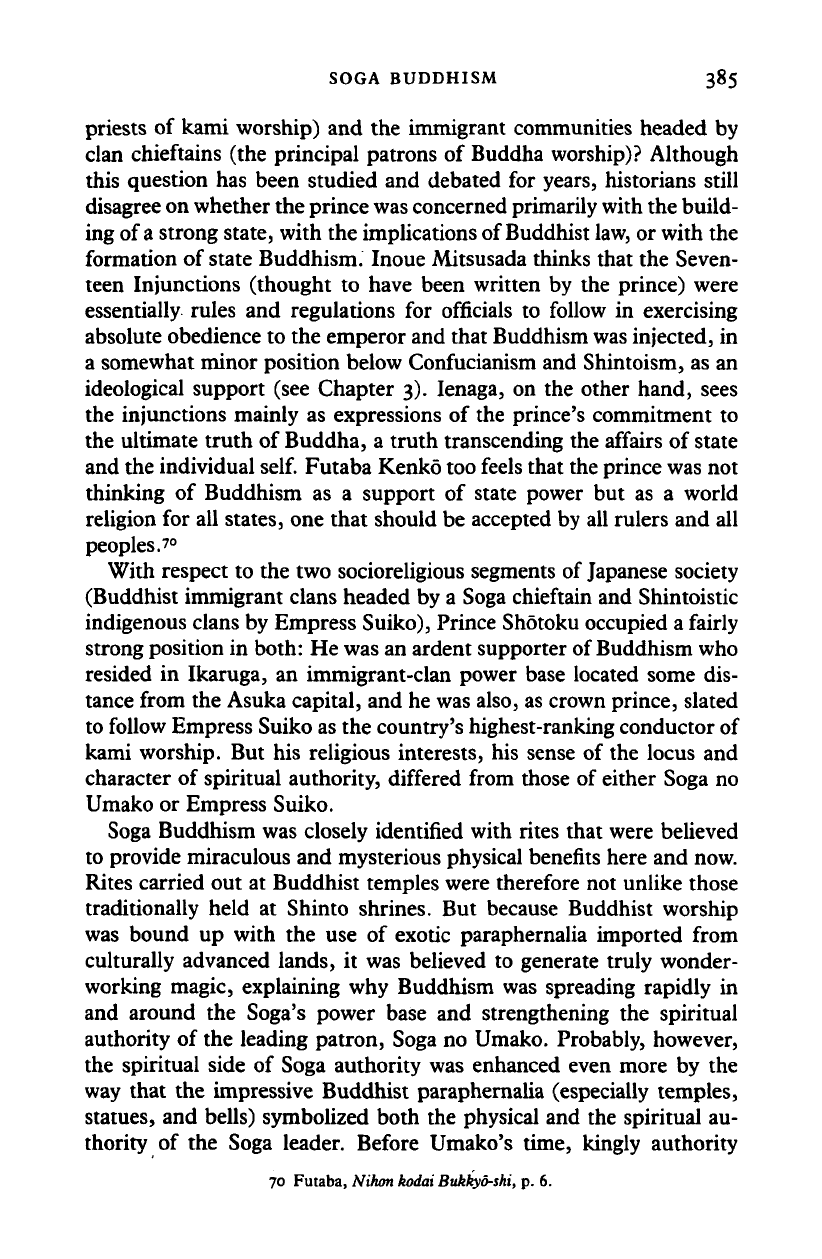
SOGA BUDDHISM 385
priests of kami worship) and the immigrant communities headed by
clan chieftains (the principal patrons of Buddha worship)? Although
this question has been studied and debated for years, historians still
disagree on whether the prince
was
concerned primarily with the build-
ing of a strong state, with the implications of Buddhist law, or with the
formation of state Buddhism. Inoue Mitsusada thinks that the Seven-
teen Injunctions (thought to have been written by the prince) were
essentially rules and regulations for officials to follow in exercising
absolute obedience to the emperor and that Buddhism was injected, in
a somewhat minor position below Confucianism and Shintoism, as an
ideological support (see Chapter 3). Ienaga, on the other hand, sees
the injunctions mainly as expressions of the prince's commitment to
the ultimate truth of Buddha, a truth transcending the affairs of state
and the individual
self.
Futaba Kenko too feels that the prince was not
thinking of Buddhism as a support of state power but as a world
religion for all states, one that should be accepted by all rulers and all
peoples. 7°
With respect to the two socioreligious segments of Japanese society
(Buddhist immigrant clans headed by a Soga chieftain and Shintoistic
indigenous clans by Empress Suiko), Prince Shotoku occupied a fairly
strong position in both: He was an ardent supporter of Buddhism who
resided in Ikaruga, an immigrant-clan power base located some dis-
tance from the Asuka capital, and he was also, as crown prince, slated
to follow Empress Suiko as the country's highest-ranking conductor of
kami worship. But his religious interests, his sense of the locus and
character of spiritual authority, differed from those of either Soga no
Umako or Empress Suiko.
Soga Buddhism was closely identified with rites that were believed
to provide miraculous and mysterious physical benefits here and now.
Rites carried out at Buddhist temples were therefore not unlike those
traditionally held at Shinto shrines. But because Buddhist worship
was bound up with the use of exotic paraphernalia imported from
culturally advanced lands, it was believed to generate truly wonder-
working magic, explaining why Buddhism was spreading rapidly in
and around the Soga's power base and strengthening the spiritual
authority of the leading patron, Soga no Umako. Probably, however,
the spiritual side of Soga authority was enhanced even more by the
way that the impressive Buddhist paraphernalia (especially temples,
statues, and bells) symbolized both the physical and the spiritual au-
thority of the Soga leader. Before Umako's time, kingly authority
70 Futaba, Nihon kodai Bukkyo-shi, p. 6.
Cambridge Histories Online © Cambridge University Press, 2008
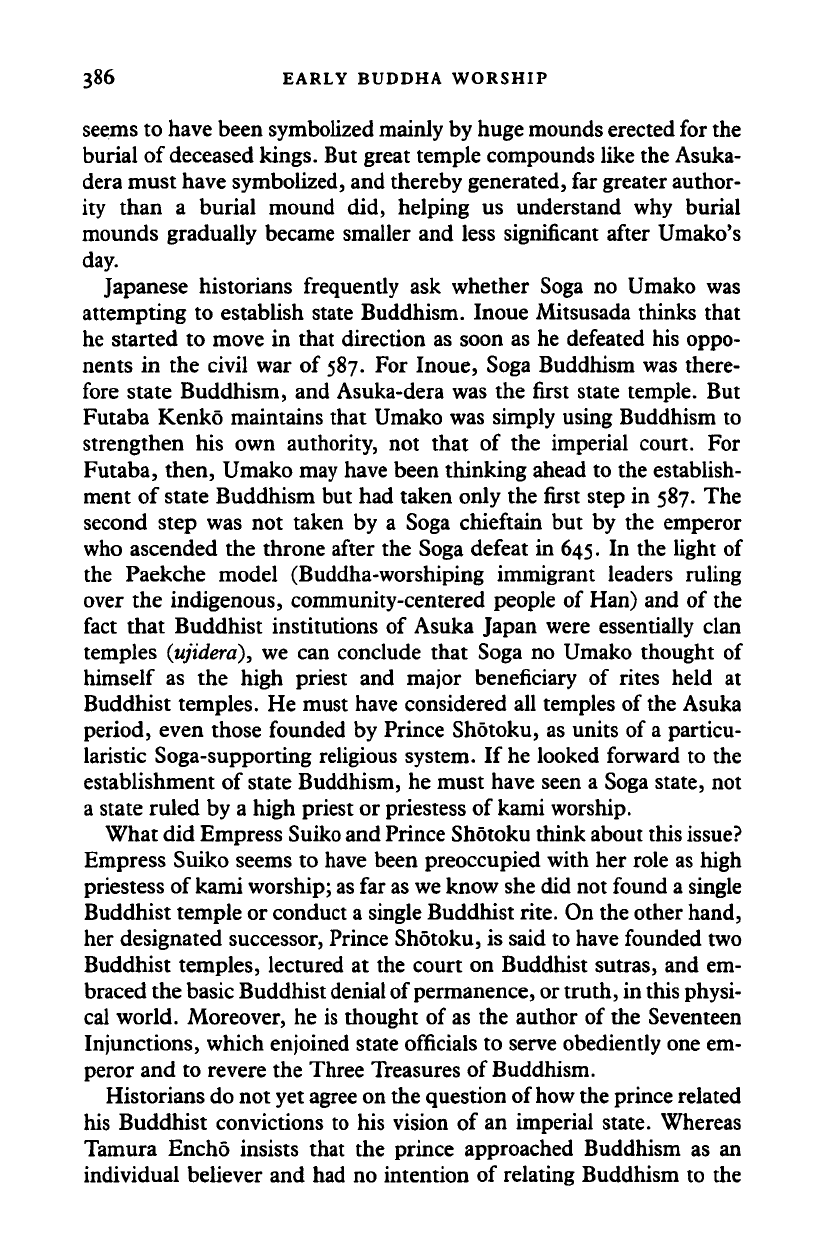
386 EARLY BUDDHA WORSHIP
seems to have been symbolized mainly by huge mounds erected for the
burial of deceased kings. But great temple compounds like the Asuka-
dera must have symbolized, and thereby generated, far greater author-
ity than a burial mound did, helping us understand why burial
mounds gradually became smaller and less significant after Umako's
day.
Japanese historians frequently ask whether Soga no Umako was
attempting to establish state Buddhism. Inoue Mitsusada thinks that
he started to move in that direction as soon as he defeated his oppo-
nents in the civil war of
587.
For Inoue, Soga Buddhism was there-
fore state Buddhism, and Asuka-dera was the first state temple. But
Futaba Kenko maintains that Umako was simply using Buddhism to
strengthen his own authority, not that of the imperial court. For
Futaba, then, Umako may have been thinking ahead to the establish-
ment of state Buddhism but had taken only the first step in 587. The
second step was not taken by a Soga chieftain but by the emperor
who ascended the throne after the Soga defeat in 645. In the light of
the Paekche model (Buddha-worshiping immigrant leaders ruling
over the indigenous, community-centered people of Han) and of the
fact that Buddhist institutions of Asuka Japan were essentially clan
temples (ujidera), we can conclude that Soga no Umako thought of
himself as the high priest and major beneficiary of rites held at
Buddhist temples. He must have considered all temples of the Asuka
period, even those founded by Prince Shotoku, as units of a particu-
laristic Soga-supporting religious system. If he looked forward to the
establishment of state Buddhism, he must have seen a Soga state, not
a state ruled by a high priest or priestess of kami worship.
What did Empress Suiko and Prince Shotoku think about this issue?
Empress Suiko seems to have been preoccupied with her role as high
priestess of kami worship; as far as we know she did not found a single
Buddhist temple or conduct a single Buddhist rite. On the other hand,
her designated successor, Prince Shdtoku, is said to have founded two
Buddhist temples, lectured at the court on Buddhist sutras, and em-
braced the basic Buddhist denial of permanence, or truth, in this physi-
cal world. Moreover, he is thought of as the author of the Seventeen
Injunctions, which enjoined state officials to serve obediently one em-
peror and to revere the Three Treasures of Buddhism.
Historians do not yet agree on the question of how the prince related
his Buddhist convictions to his vision of an imperial state. Whereas
Tamura Encho insists that the prince approached Buddhism as an
individual believer and had no intention of relating Buddhism to the
Cambridge Histories Online © Cambridge University Press, 2008
